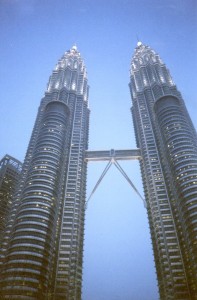I recently published a post about how Southeast Asia’s ancient cultural heritage shaped Islamic architecture in Southeast Asia. But the influence has gone both ways.
And both culture’s are so rich that their fusions create an endless banquet table. Come and pig out with me.
A lot of traditional Islamic art stresses symmetrical geometrical patterns, in which the center is emphasized and identified with God’s creative powers. His powers emanate into quincunx’s, pentagons, hexagons, octagons and stars. You see these inside of domes. The Petronas Towers in Kuala Lumpur, Malaysia (pictured above) are drop-dead gorgeous adaptations of this concept of geometry to the modern skyscraper form.
Watching them light up in the evening and shine against the sky as it slowly turns from indigo to black is unforgettable. But these Islamic motifs blend with traditional Southeast Asia. People gather in the open park under the towers to watch the show. When I was there, everyone quietly huddled together, and the gathering had the same cozy atmosphere that traditional Southeast Asian communities have. We all enjoyed the abundance of forms we all comprised, and the towers’ lights added all the more vibrancy.
So what were we participating in? Were we strictly part of God’s glory, which comes from the center. Or were we part of the endless diversity of forms and spirits that has been the Southeast Asian heritage since ancient times? I think many people’s frameworks shift between both. In Islamic Southeast Asia, you can choose between multiple reference points, and blend them as you savor the region’s endless variety of cultural fusions.
Glory to God and Southeast Asia!


Comments on this entry are closed.